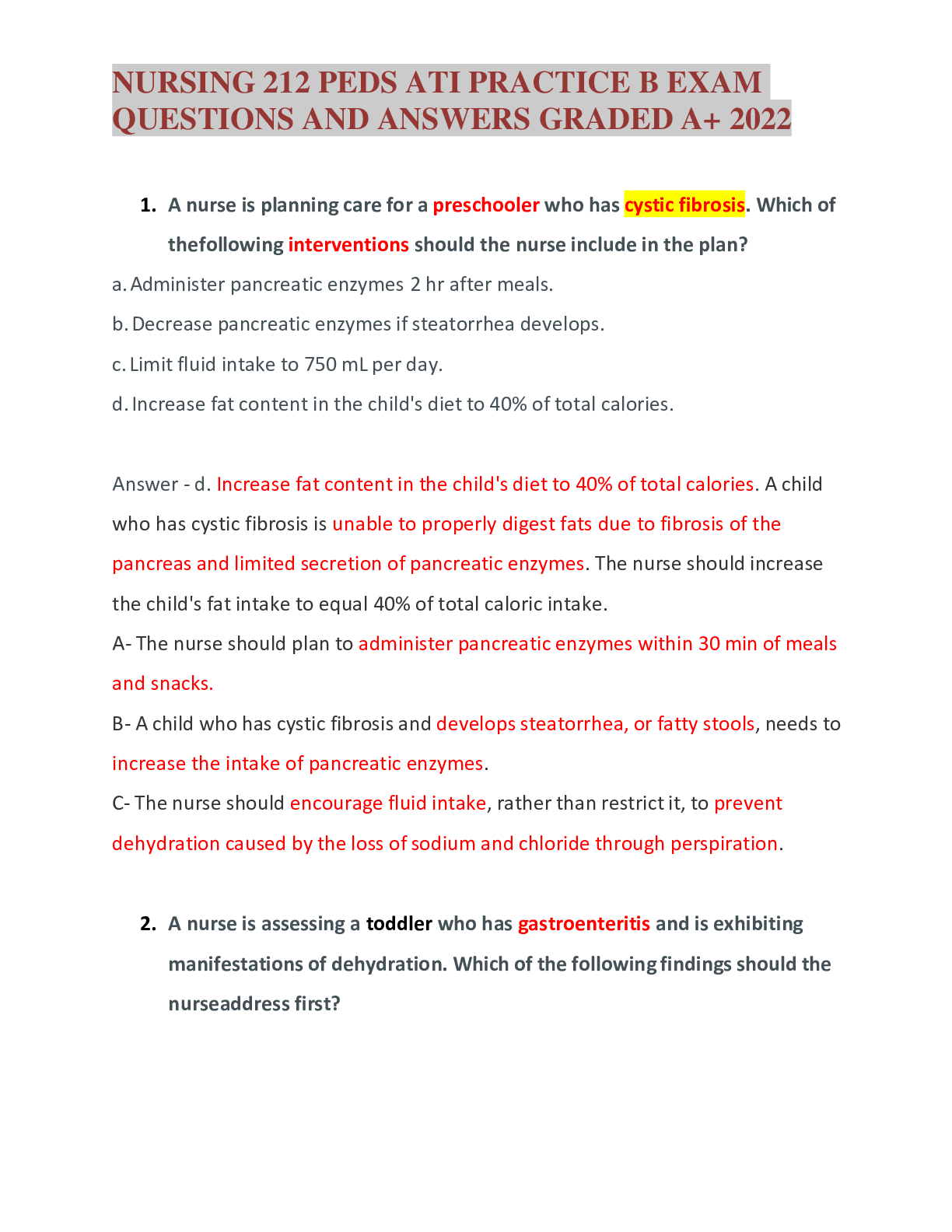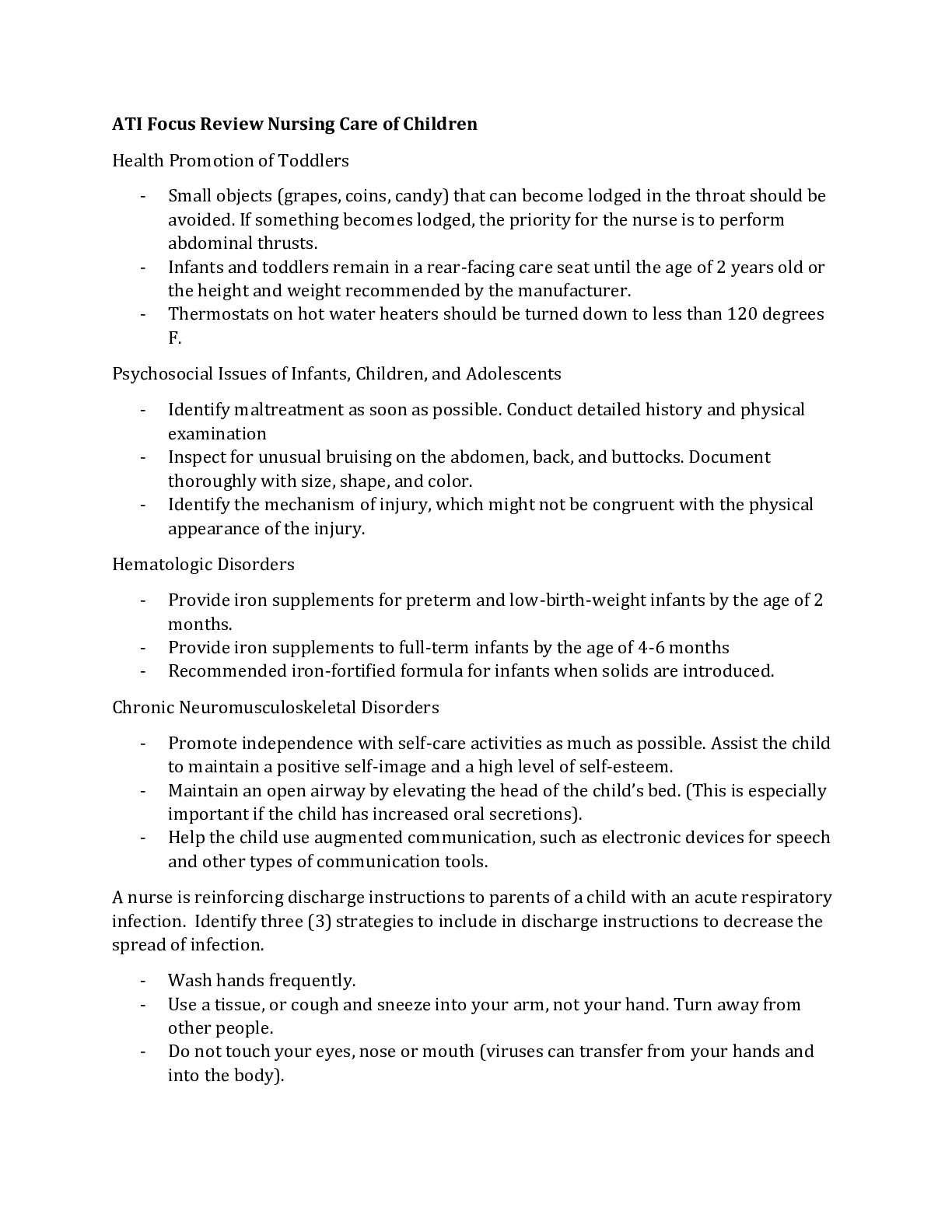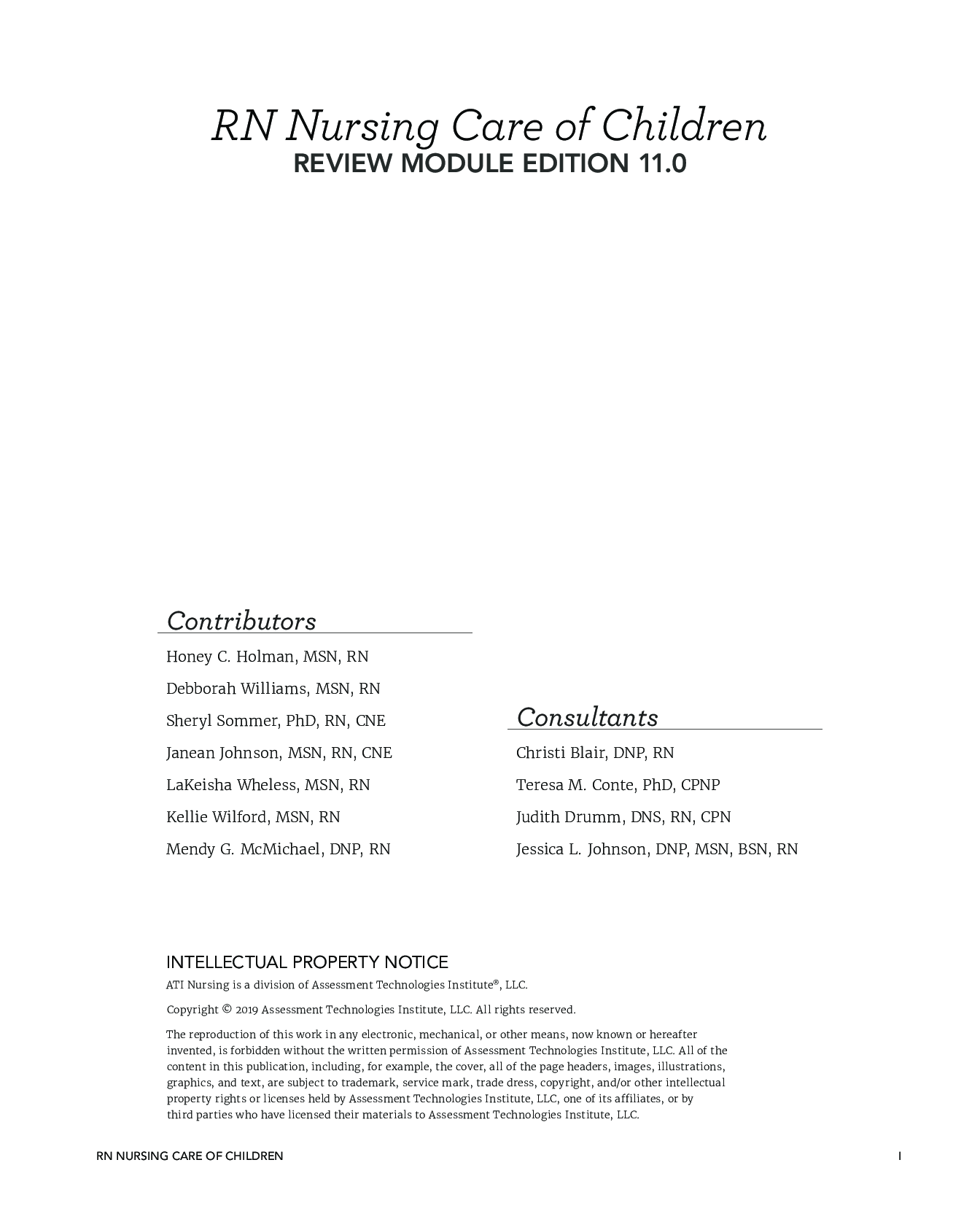*NURSING > QUESTIONS and ANSWERS > N212 ATI RN Nursing Care of Children Online Practice 2016 B | N 212 ATI RN Nursing Care of Children (All)
N212 ATI RN Nursing Care of Children Online Practice 2016 B | N 212 ATI RN Nursing Care of Children
Document Content and Description Below
N212 ATI RN Nursing Care of Children Online Practice 2016 B A nurse is assessing a 4-year-old child at a well-child visit. Which of the following developmental milestones should the nurse expect to o... bserve? a. Identifies right from left hand b. Uses a utensil to spread butter c. Cuts a shape using scissors d. Draws a stick figure with seven body parts c. Cuts a shape using scissors A- Identifying the right from left hand is an expected developmental milestone of a 6-year-old child. B- Using a utensil to spread butter is an expected developmental milestone of a 6-year-old child. D- Drawing a stick figure with seven body parts is an expected developmental milestone of a 5-year-old child. A school nurse is preparing to administer atomoxetine 1.2 mg/kg/day PO to a school-age child who weighs 75lb. Available is atomexetine 40 mg/capsule. How many capsules should the nurse administer per day? 1 A nurse in the emergency department is assessing a toddler who has Kawasaki disease. Which of the following findings should the nurse expect? (select all that apply.) a. Increased temperature b. Gingival hyperplasia c. Xerophthalmia d. Bradycardia e. Cervical lymphadenopathy Answer- a,c,e Increased temperature is correct. Kawasaki disease is an acute illness associated with a fever lasting more than 4 days that is unresponsive to antipyretics or antibiotics. Gingival hyperplasia is incorrect. Children who have Kawasaki disease develop a strawberry tongue, cracked lips, and edema of the oral mucosa and pharynx. A child who is receiving phenytoin therapy can develop gingival hyperplasia. Xerophthalmia is correct. Ophthalmic manifestations of Kawasaki disease include reddening of the conjunctiva and dryness of the eyes, or xerophthalmia. Bradycardia is incorrect. Kawasaki disease is an infection that affects the vascular system, including the heart. The nurse should expect the child to be tachycardic with a gallop rhythm. Long term effects of Kawasaki disease include the development of coronary artery aneurysms or myocardial infarction. Cervical lymphadenopathy is correct. The child who has Kawasaki disease may develop enlarged cervical nodes on one side of the neck that are nontender and greater than 1.5 cm in size. A nurse is teaching a school-age child who has a new diagnosis of type 1 diabetes MELITIS. The nurse should identify which of the following statements by the child as understanding the teaching? a. I will puncture the pad of my finger when I am testing my blood glucose." b. "I will give myself a shot of regular insulin 30 minutes before I eat breakfast." c. "I will eat a snack of 5 grams of carbohydrates if my blood glucose is low." d. "I will decrease the amount of fluids I drink when I am sick." Answer- b. "I will give myself a shot of regular insulin 30 minutes before I eat breakfast." The child should administer regular insulin 30 min before meals so that the onset coincides with food intake. A- The child should avoid puncturing the pads of the fingers because they have fewer blood vessels and more nerve fibers. Instead, the child should puncture the skin to either side of the finger pad to promote blood flow and decrease pain. C- The child should eat a snack of 15 g of carbohydrates, such as 120 mL (4 oz) of fruit juice or 66 g (1/2 cup) of ice cream, to rapidly increase a mild hypoglycemic reaction. D- During acute illness the child is prone to hyperglycemia and ketonuria and is at risk for dehydration. Therefore, the child's fluid intake should increase rather than decrease. A school nurse is assessing an adolescent who has scoliosis. Which of the following findings should the nurse expect? a. Increase in anterior convexity of the lumbar spine b. Increased curvature of the thoracic spine c. Lateral flexion of the neck d. A unilateral rib hump Answer- d. A unilateral rib hump When assessing an adolescent for scoliosis, the school nurse should expect to see a unilateral rib hump with hip flexion. This results from a lateral S- or C-shaped curvature to the thoracic spine resulting in asymmetry of the ribs, shoulders, hips, or pelvis. Scoliosis can be the result of a neuromuscular or connective tissue disorder, or it can be congenital in nature. A- An increased anterior convexity of the lumbar spine is a manifestation of lordosis. An expected finding in toddlers, lordosis can indicate a complication of a disease process, such as flexion contractures, congenital dislocation of the hip, or obesity, when seen in older children. B- An increased curvature of the thoracic spine is a manifestation of kyphosis. Kyphosis can be a manifestation of a congenital condition or disease process such as rickets, or it can be posture-related. In posture-related kyphosis, the adolescent presents with rounded shoulders and a slouching posture. C- Lateral flexion of the neck is an indication of torticollis as a result of contracture of the sternocleidomastoid muscle. Torticollis can be congenital, the result of intrauterine fetal posturing or abnormality of the cervical spine, or it can be acquired, due to such factors as a traumatic lesion to the sternocleidomastoid muscle. A nurse is reviewing the lumbar puncture results of a school-age child suspected of having bacterial meningitis. Which of the following results should the nurse identify as a finding associated with bacterial meningitis? a. Decreased cerebrospinal fluid pressure b. Decreased WBC count c. Increased protein concentration d. Increased glucose level Answer- c. Increased protein concentration. The nurse should recognize that an increased protein concentration in the spinal fluid is a finding associated with bacterial meningitis. A- Increased cerebrospinal fluid pressure is a finding associated with bacterial meningitis. B- An increased WBC count in the spinal fluid is a finding associated with bacterial meningitis. D- A decreased glucose level in the spinal fluid is a finding associated with bacterial meningitis. A nurse is planning care for a preschooler who has cystic fibrosis. Which of the following interventions should the nurse include in the plan? a. Administer pancreatic enzymes 2 hr after meals. b. Decrease pancreatic enzymes if steatorrhea develops. c. Limit fluid intake to 750 mL per day. d. Increase fat content in the child's diet to 40% of total calories. Answer - d. Increase fat content in the child's diet to 40% of total calories. A child who has cystic fibrosis is unable to properly digest fats due to fibrosis of the pancreas and limited secretion of pancreatic enzymes. The nurse should increase the child's fat intake to equal 40% of total caloric intake. A- The nurse should plan to administer pancreatic enzymes within 30 min of meals and snacks. B- A child who has cystic fibrosis and develops steatorrhea, or fatty stools, needs to increase the intake of pancreatic enzymes. C- The nurse should encourage fluid intake, rather than restrict it, to prevent dehydration caused by the loss of sodium and chloride through perspiration. A nurse is assessing a toddler who has gastroenteritis and is exhibiting manifestations of dehydration. Which of the following findings should the nurse address first? a. Skin breakdown b. Hypotension c. Hyperpyrexia d. Tachypnea Answer- d. Tachypnea. When using the airway, breathing, circulation approach to client care, the first finding the nurse should address is the toddler's tachypnea, which results when the kidneys are unable to excrete hydrogen ions and produce bicarbonate leading to metabolic acidosis. A- Toddlers who have gastroenteritis and are dehydrated are at increased risk for skin breakdown because of changes in circulation and loss of skin elasticity. However, the nurse should address another finding first. B- Toddlers who have gastroenteritis and are dehydrated may exhibit hypotension because of reduced blood volume. However, the nurse should address another finding first. C- Toddlers who have gastroenteritis and are dehydrated may exhibit hyperpyrexia, or fever, which is caused by the effect of fluid volume depletion on the hypothalamus. However, the nurse should address another finding first. A nurse is discussing organ donation with the parents of a school-age child who has sustained brain death due to a bicycling accident. Which of the following actions should the nurse take first? a. Inform the parents that written consent is required prior to organ donation. b. Provide written information to the parents about organ donation. c. Ask the provider to explain misconceptions of organ donation to the parents. d. Explore the parents' feelings and wishes regarding organ donation. Answer- d. Explore the parents' feelings and wishes regarding organ donation. The first action the nurse should take when using the nursing process is assessment. Exploring the parents' feelings and wishes regarding organ donation will assist the nurse in determining if organ donation is appropriate for this family and should be done prior to taking other actions. A- The nurse should inform the parents that written consent is required prior to organ donation to document that the parents have consented to organ donation and that the provider has addressed any questions or concerns the parents may have. However, there is another action that the nurse should take first. B- The nurse should provide written information to the parents to enhance their understanding about organ donation. However, there is another action that the nurse should take first. C- The nurse should ask the provider to explain misconceptions of organ donation to the parents, because it is important that they have accurate information before making a final decision. However, there is another action that the nurse should take first. A nurse in an emergency department is caring for a school-age child who has appendicitis and rates his abdominal pain 7 on a 0 to 10 scale. Which of the following actions should the nurse take? a. Instill a 500 mL tap water enema. b. Give morphine 0.05mg/kg IV. c. Administer polyethylene glycol 1g/kg PO. d. Apply a heating pad to the child's abdomen. Answer- b. Give morphine 0.05mg/kg IV. A pain level of 7 on a 0 to 10 scale is considered severe and the nurse should administer an analgesic medication for pain relief. A- Administering an enema accelerates bowel motility and increases the risk for perforation of the appendix. C- Administering laxatives accelerates bowel motility and increases the risk for perforation of the appendix. D- Applying heat to the child's abdomen increases the risk for perforation of the appendix. A nurse is monitoring the oxygen saturation level of an infant using pulse oximetry. The nurse should secure the sensor to which of the following areas on the infant? a. Wrist b. Great toe c. Index finger d. Heel Answer - b. Great toe. The nurse should secure the sensor to the great toe of the infant and then place a snug-fitting sock on the foot to hold the sensor in place. The nurse should also check the skin under the sensor site frequently for pulses, temperature, and color. A- It is important for the sensor to be positioned in the correct area in order to obtain an accurate reading. The nurse should avoid placing the sensor on the wrist because this placement will result in an inaccurate reading. C- The nurse should secure the sensor to the index finger of an older child and then use a self-adhering bandage to hold the sensor in place. D- It is important for the sensor to be positioned in the correct area in order to obtain an accurate reading. The nurse should avoid placing the sensor on the heel of the infant's foot because this placement will result in an inaccurate reading. A nurse is assessing a school-age child who has an infratentorial brain tumor. Which of the following findings should the nurse identify as a manifestation of increased intracranial pressure? a. Hypotension b. Hyperactivity c. Decreased attention span d. Tachycardia Answer- c. Decreased attention span. The nurse should recognize decreased attention span, inability to follow commands, and difficulty in school are manifestations of increased intracranial pressure because of the decreased blood flow within the brain. - - - - - - -- - - - - - - - - - - - - -- -- - - - - - - - - - - - - -A nurse is providing teaching to the parent of a preschooler about ways to prevent acute asthma attacks. Which fo the following statements by the parent should the nurse identify as understanding the teaching? a. "I will use a humidifier in my child's room at night." b. "I will give my child a cough suppressant every six hours if he has a cough." c. "I should avoid using a wet mop on my floors when I am cleaning." d. "I should keep my child indoors when I mow the yard." Answer- d. "I should keep my child indoors when I mow the yard." The nurse should instruct the parent to keep the preschooler indoors during lawn maintenance or when the pollen count is increased. Guarding against exposure to known allergens found outdoors, such as grass, tree, and weed pollen, will decrease the frequency of the preschooler's asthma attacks. A- Dehumidifiers or air conditioners are recommended to control the room temperature because heat and humidification can cause an asthma exacerbation. B- Cough suppressants are contraindicated for children who have asthma because they need to be able to cough up mucus to keep their airway open. C- The parent should wet mop bare floors weekly because sweeping floors can trigger an asthma attack due to the inhalation of the dust that becomes airborne during sweeping. A nurse is providing discharge teaching to the parents of a Caucasian toddler who had a lower leg cast applied 24 hr ago. The nurse should instruct the parents to report which of the following findings to the provider? a. Capillary refill time less than 2 seconds b. Restricted ability to move the toes c. Swelling of the casted foot when the leg is dependent d. Toes that are deep pink in color Answer- b. Restricted ability to move the toes. The nurse should inform the parents that a restricted ability of the toddler to move his toes is a sign of neurovascular compromise and requires immediate notification of the provider. Permanent muscle and tissue damage may occur in just a few hours. A- Capillary refill time is assessed to determine circulatory status by pressing lightly on the tips of the toes until the skin has blanched. A capillary refill time that is greater than 2 seconds indicates circulatory compromise and should be reported to the provider immediately. C- Swelling of the casted foot when the leg is dependent is an expected finding. The nurse should instruct the parents that frequent rest is needed for the next several days, and that the casted foot should not be in a dependent position for more than 30 min. When the toddler is resting, the casted extremity should be elevated on a pillow at chest level to minimize swelling. D- Toes that are deep pink in color is an expected finding for a Caucasian toddler and does not warrant provider notification. A nurse is planning care for a school-age-child who is in the oliguric phase of acute kidney injury (AKI) and has a sodium level of 129 mEq/L. Which of the following interventions should the nurse include in the plan? a. Administer ibuprofen to the child for a temperature greater than 38º C (101º F). b. Assess the child's blood pressure every 8 hr. c. Weigh the child weekly at various times of the day. d. Initiate seizure precautions for the child. Answer- d. Initiate seizure precautions for the child. A sodium level of 129 mEq/L indicates hyponatremia and places the child at increased risk for neurological deficits and seizure activity. The nurse should complete a neurologic assessment and implement seizure precautions in order to maintain the child's safety. A- A child who has AKI can develop a fever due to an infection. Because AKI is a contraindication to receiving medications that are nephrotoxic, such as NSAIDs, the nurse should use compensatory measures, such as turning on a fan in the room. B- A child who has AKI often is hypertensive due to fluid volume excess and the activation of the renin-angiotensin system. To prevent complications, such as hypertensive encephalopathy, the nurse should assess the child's blood pressure every 4 to 6 hr. C- In the oliguric phase of AKI, the child will have decreased urine output and fluid retention. This can result in water intoxication, which predisposes the child to neurologic alterations, such as seizures. To ensure accurate evaluation of fluid balance, the nurse should plan to weigh the child daily, at the same time, in the same clothing and using the same scale. A nurse is assessing a 6-month-old infant as a well-infant visit. Which of the following should the nurse report to the provider? a. Presence of strabismus b. Presence of corneal light reflex c. Presence of open anterior fontanel d. Presence of cerumen Answer- a. Presence of strabismus. Strabismus, or crossing of the eyes, disappears at 3 - 4 months of age. Therefore, the nurse should report this finding to the provider. B- The nurse should recognize that the presence of a corneal light reflex is an expected finding and is not necessary to report to the provider. C- The nurse should recognize that the presence of an open anterior fontanel is an expected finding and is not necessary to report to the provider. D- The nurse should recognize that the presence of cerumen is an expected finding and is not necessary to report to the provider. A nurse is planning care for a school-age child who has a tunneled central venous access device. Which of the following interventions should the nurse include in the plan? a. Use sterile scissors to remove the dressing from the site. b. Irrigate each lumen weekly with 10 mL of 0.9% sodium chloride solution when not in use. c. Access the site using a noncoring angled needle. d. Use a semipermeable transparent dressing to cover the site. Answer- d. Use a semipermeable transparent dressing to cover the site. The nurse should cover the site with a semipermeable transparent dressing to reduce the risk of infection. A- The nurse should avoid the use of scissors when performing dressing changes because this can result in accidental cutting of the catheter. B- The nurse should flush each lumen of the catheter with a heparin solution daily when not in use. C- The nurse should use a noncoring angled or straight needle when accessing an implanted port. A nurse is creating a plan of care for a school-age child who has heart disease and has developed heart failure. Which of the following interventions should the nurse include in the plan? a. Provide small, frequent meals to the child. b. Schedule time in the play room for the child. c. Weigh the child weekly. d. Maintain the child in a supine position. Answer- a. Provide small, frequent meals to the child. The metabolic rate for a child who has heart failure is high because of poor cardiac function. Therefore, the nurse should provide small, frequent meals to the child because it helps to conserve energy. B- The nurse should restrict play activities to the child's bed to minimize energy expenditure. C- The nurse should weigh the child daily. D- To provide for maximum chest expansion, the nurse should maintain the bed in a semi-Fowler's position while the child is in bed. A nurse in an emergency department is caring for a school-age child who has sustained a superficial minor burn from fireworks on his forearm. Which or the following actions should the nurse take? a. Administer a tetanus toxoid if more than 1 year since prior dose. b. Use an antimicrobial ointment on the affected area. c. Leave the burn area open to air. d. Place an ice pack on the affected area. Answer- b. Use an antimicrobial ointment on the affected area. The nurse should apply an antimicrobial ointment to the burned area to prevent infection. A- The nurse should administer a tetanus toxoid if it has been more than 5 years since the prior dose. C- The nurse should apply a clean-dry dressing of fine mesh gauze and a light gauze dressing that restricts movement to prevent injury to the wound. D- Applying ice to the affected area may impair circulation to the area and increase tissue damage. A nurse is caring for a school-age who has acute rheumatic fever. Which of the following actions should the nurse take? a. Limit the child's sodium intake. b. Place a "no visitors" sign on the child's door. c. Maintain the child on bed rest. d. Avoid administering salicylates to the child. Answer- c. Maintain the child on bed rest. The nurse should maintain the child on bed rest as well as limit the child's activity during the acute phase of rheumatic fever to assist with the prevention of cardiac damage. A- Rheumatic fever is an inflammatory disease resulting from an immune response that involves the heart, joints, skin, and central nervous system. Therefore, there is no indication or benefit to limiting the child's sodium intake. B- Rheumatic fever is not contagious to others. Therefore, unless it is requested by the parents or child, it is not necessary to restrict visitors. D- The nurse should administer salicylates to the child who has acute rheumatic fever to decrease fever and discomfort and help to control the inflammatory process. A nurse in an emergency department is auscultating the lungs of an adolescent who is experiencing dyspnea. The nurse should identify the sound as which of the following (audio clip)? a. Wheezes b. Crackles c. Pleural friction rub d. Rhonchi Answer- a. Wheezes. The nurse should identify the sound during auscultation as wheezes, which are high-pitched, musical or whistling-like sounds heard primarily on expiration as air passes through and vibrates narrowed airways. B- Crackles are high-pitched, short, and noncontinuous sounds heard usually at the end of inspiration. Crackles occur when air expands deflated alveoli or when the passage of air through small airways is disrupted. C- A pleural friction rub is a loud, rough, grating sound and can be heard during inspiration or expiration. A pleural friction rub occurs when the pleurae are inflamed and the surfaces rub together. D- Rhonchi are low-pitched, continuous sounds that have a snore-like quality and are usually louder during expiration. Rhonchi occur when the larger airways are obstructed. [Show More]
Last updated: 1 year ago
Preview 1 out of 41 pages
Instant download

Buy this document to get the full access instantly
Instant Download Access after purchase
Add to cartInstant download
Reviews( 0 )
Document information
Connected school, study & course
About the document
Uploaded On
Jan 26, 2021
Number of pages
41
Written in
Additional information
This document has been written for:
Uploaded
Jan 26, 2021
Downloads
0
Views
30

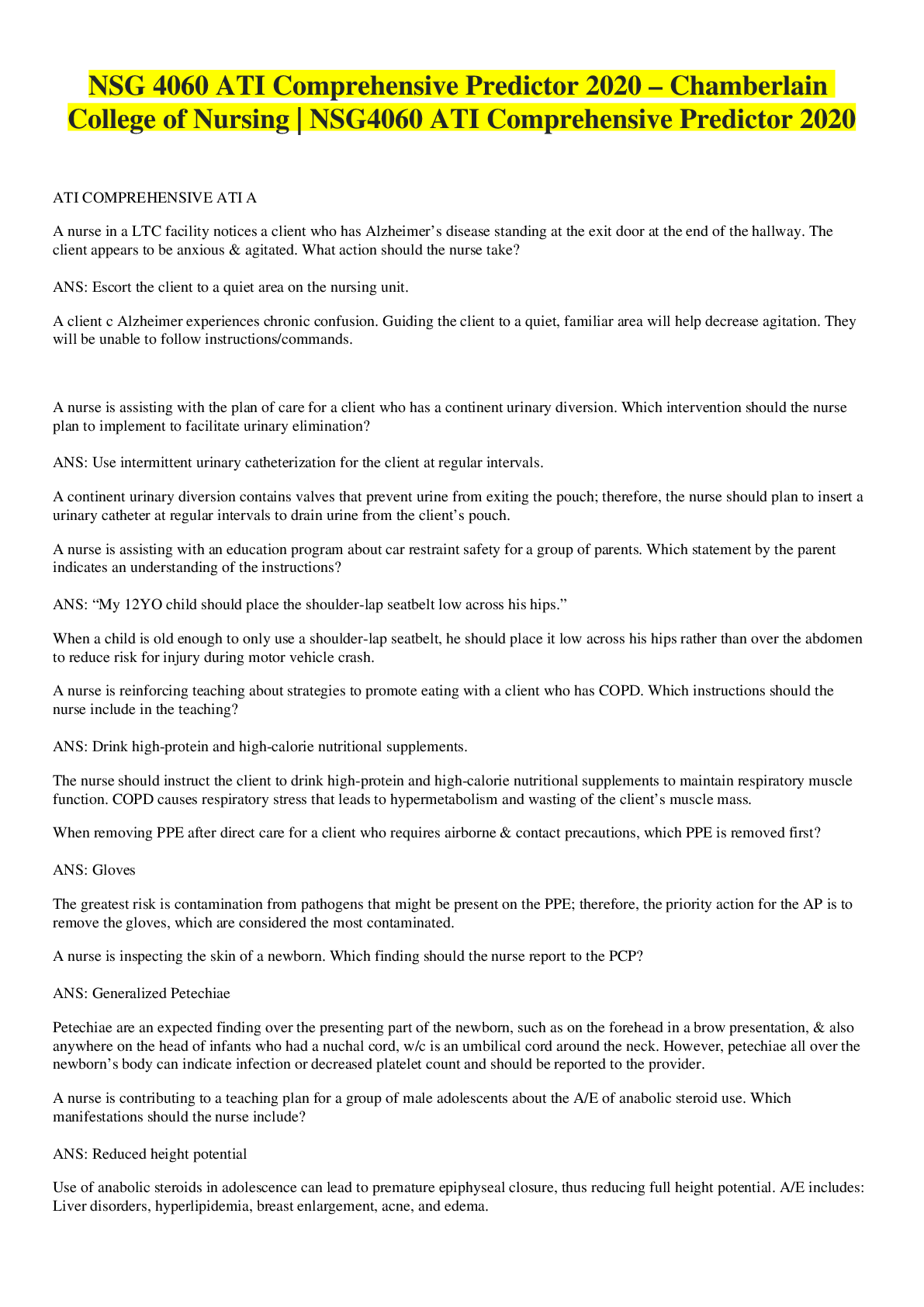


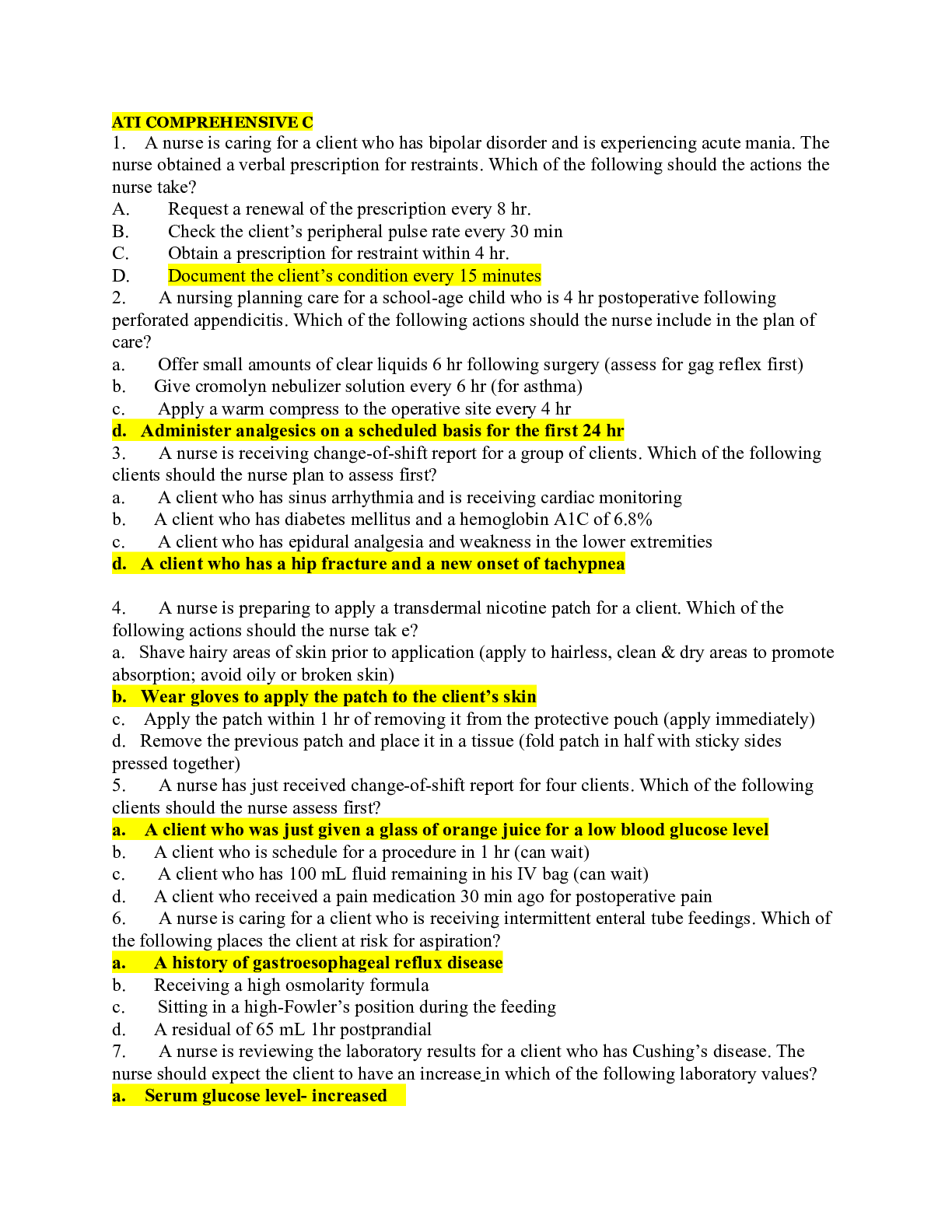
 – Concorde career College.png)
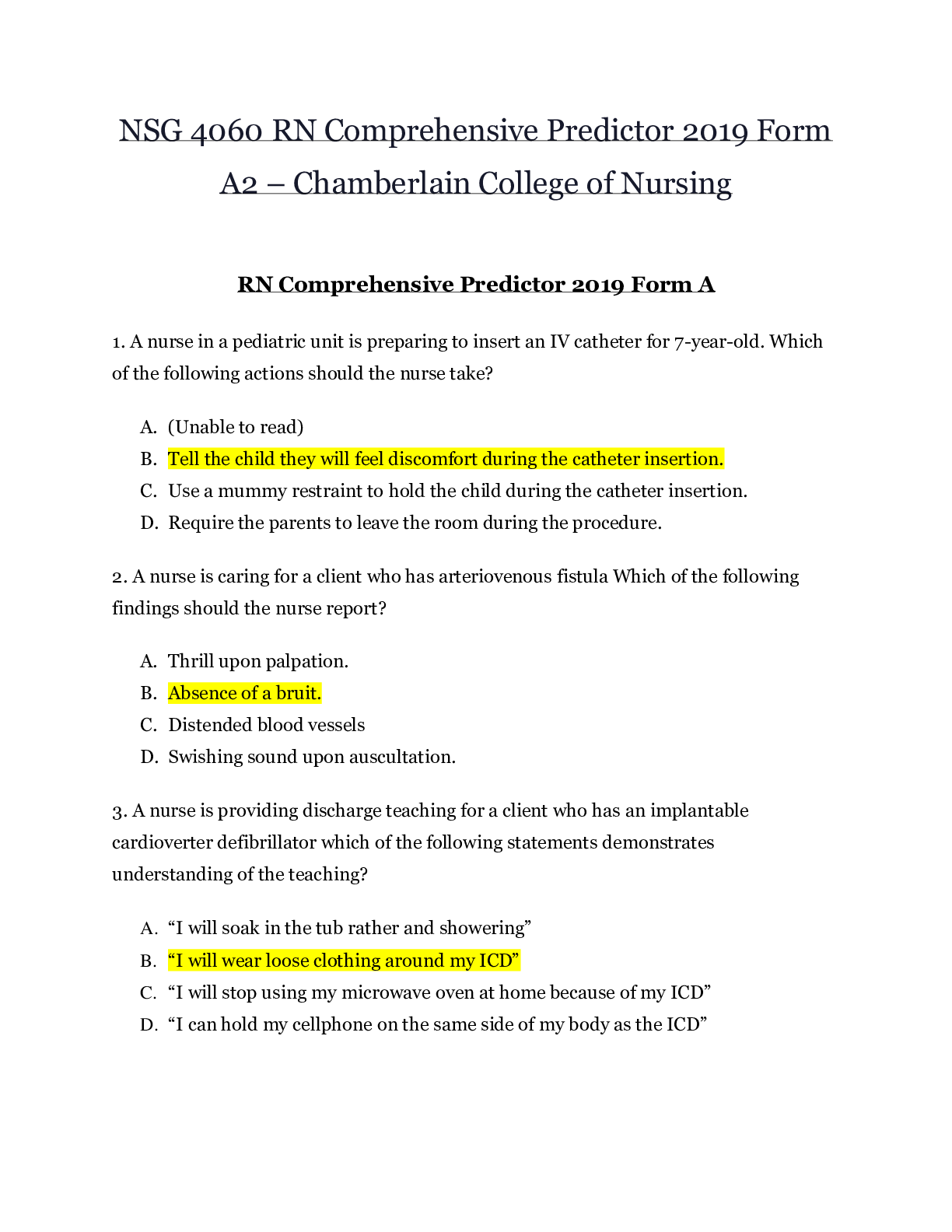
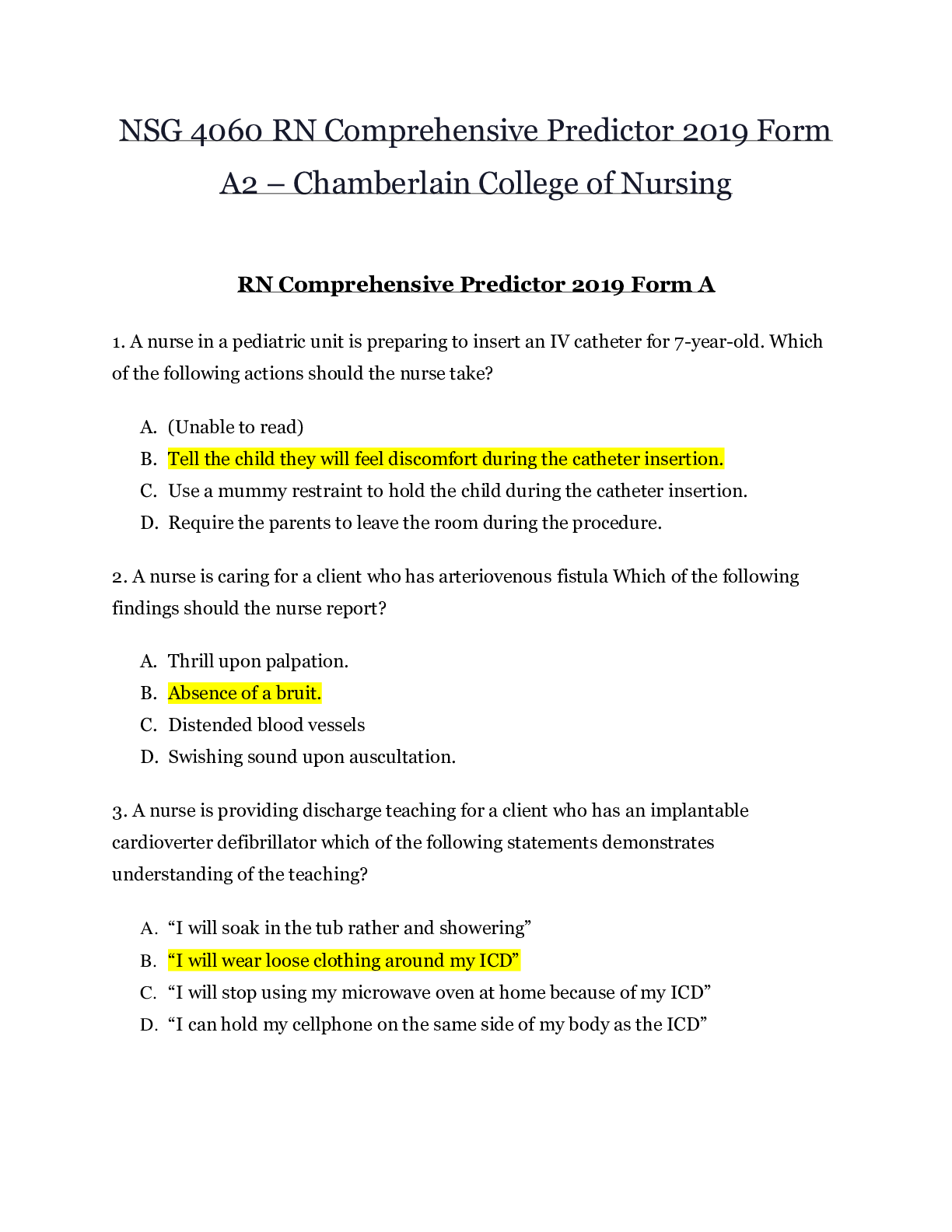

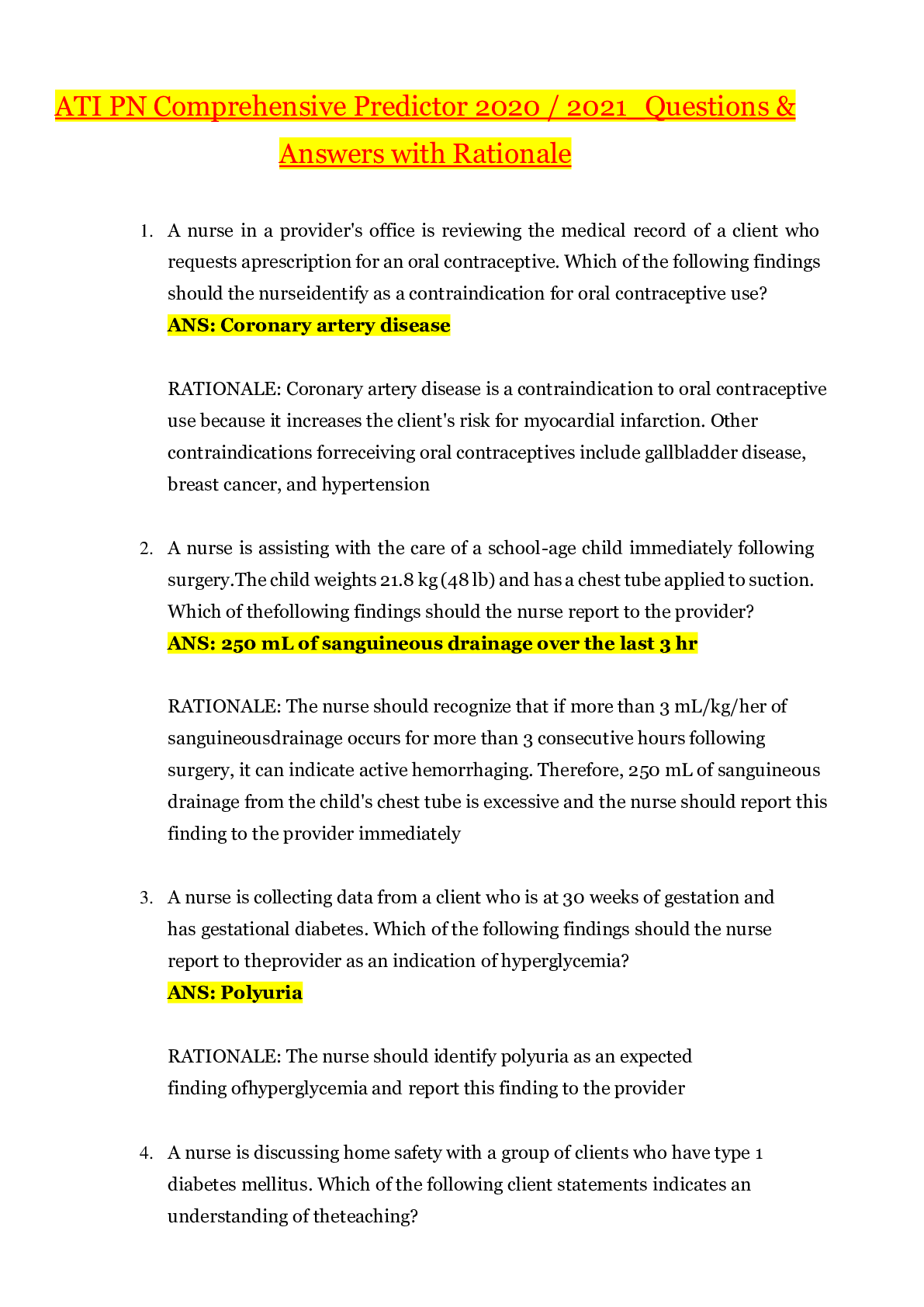
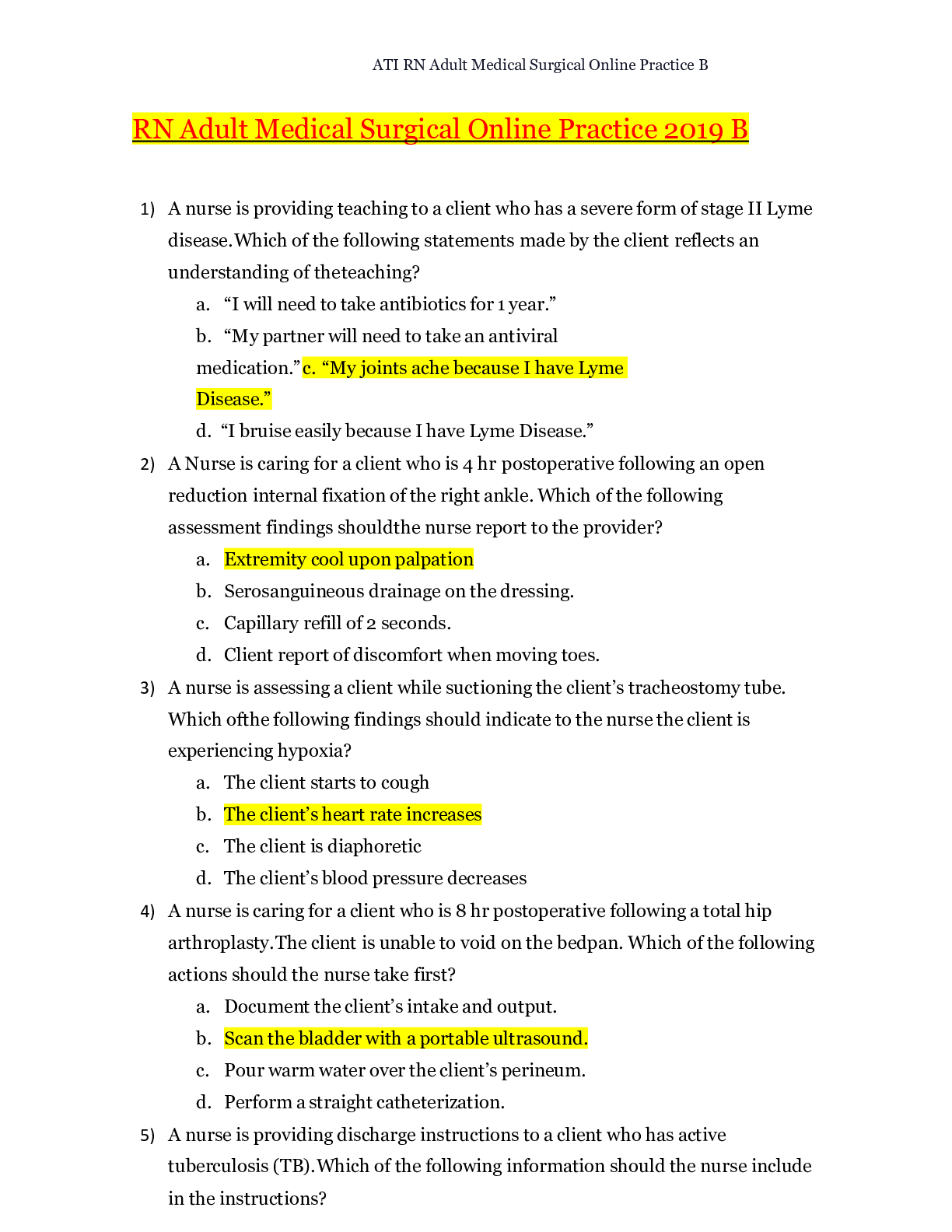
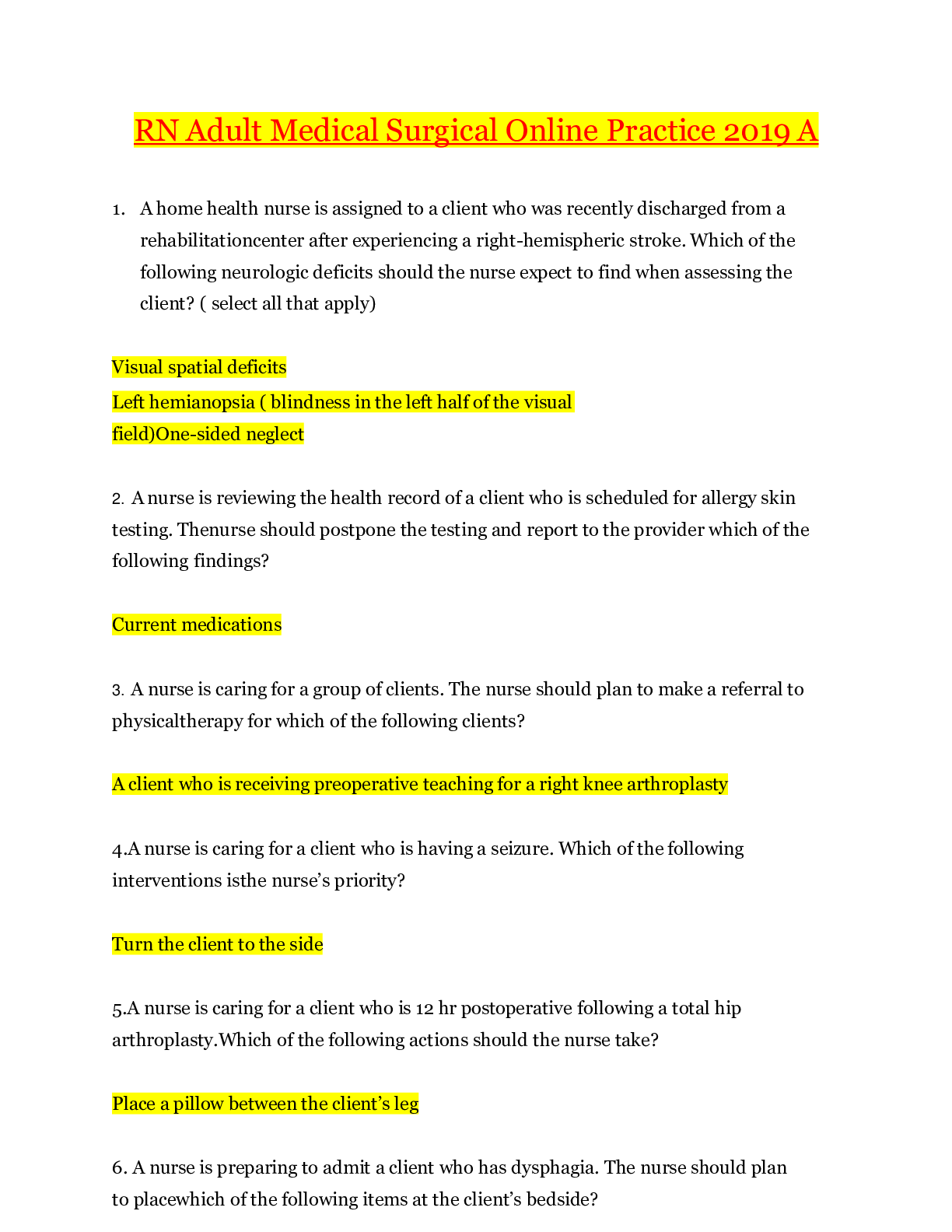
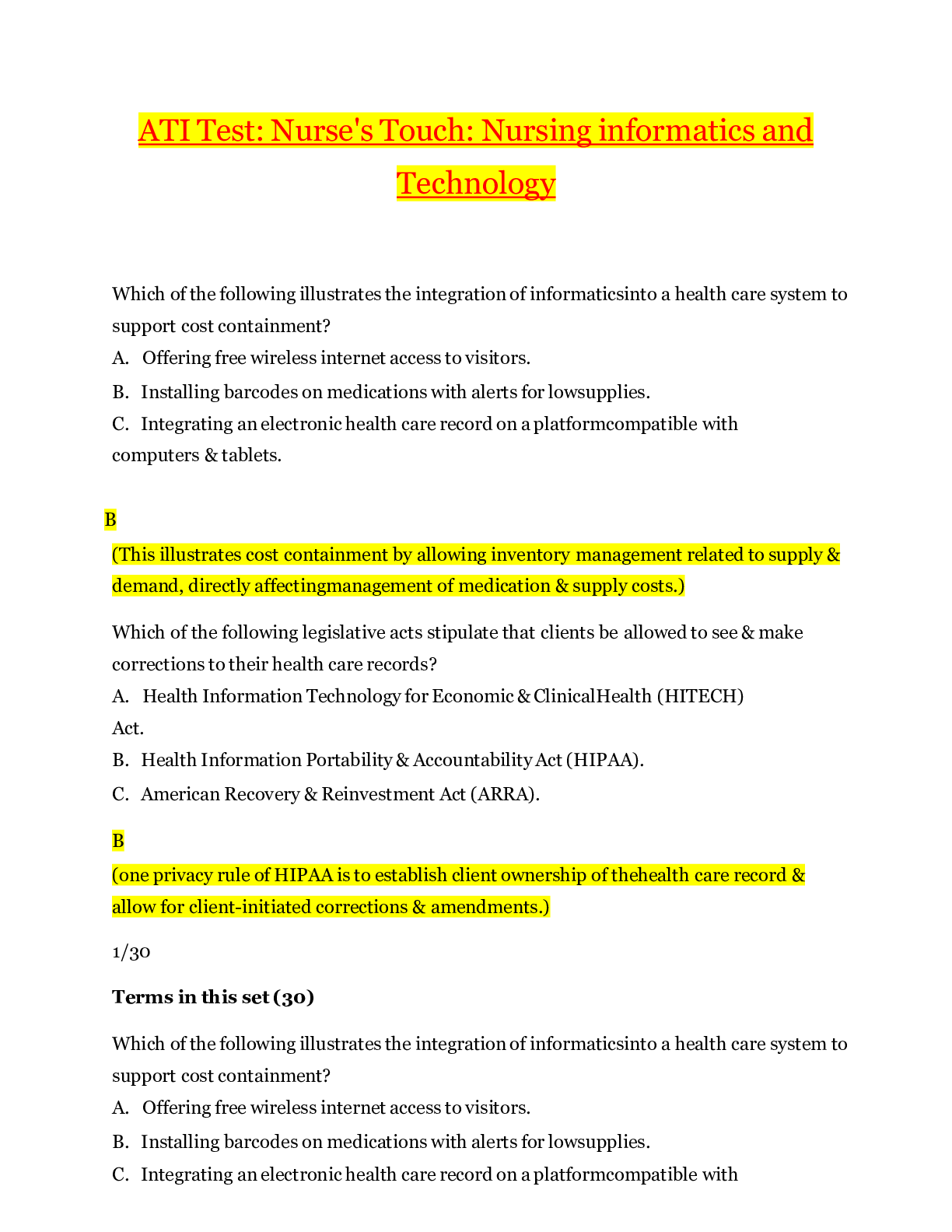
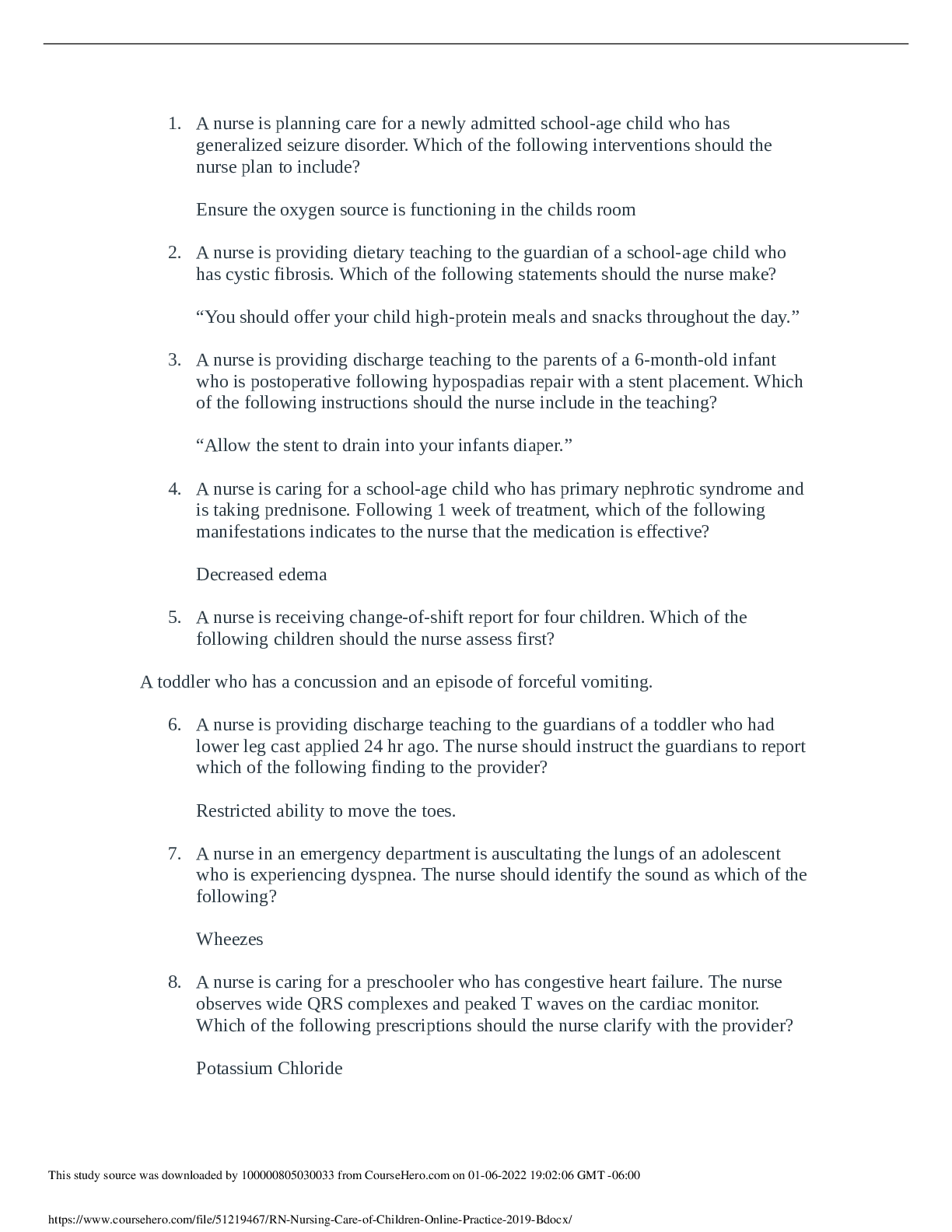
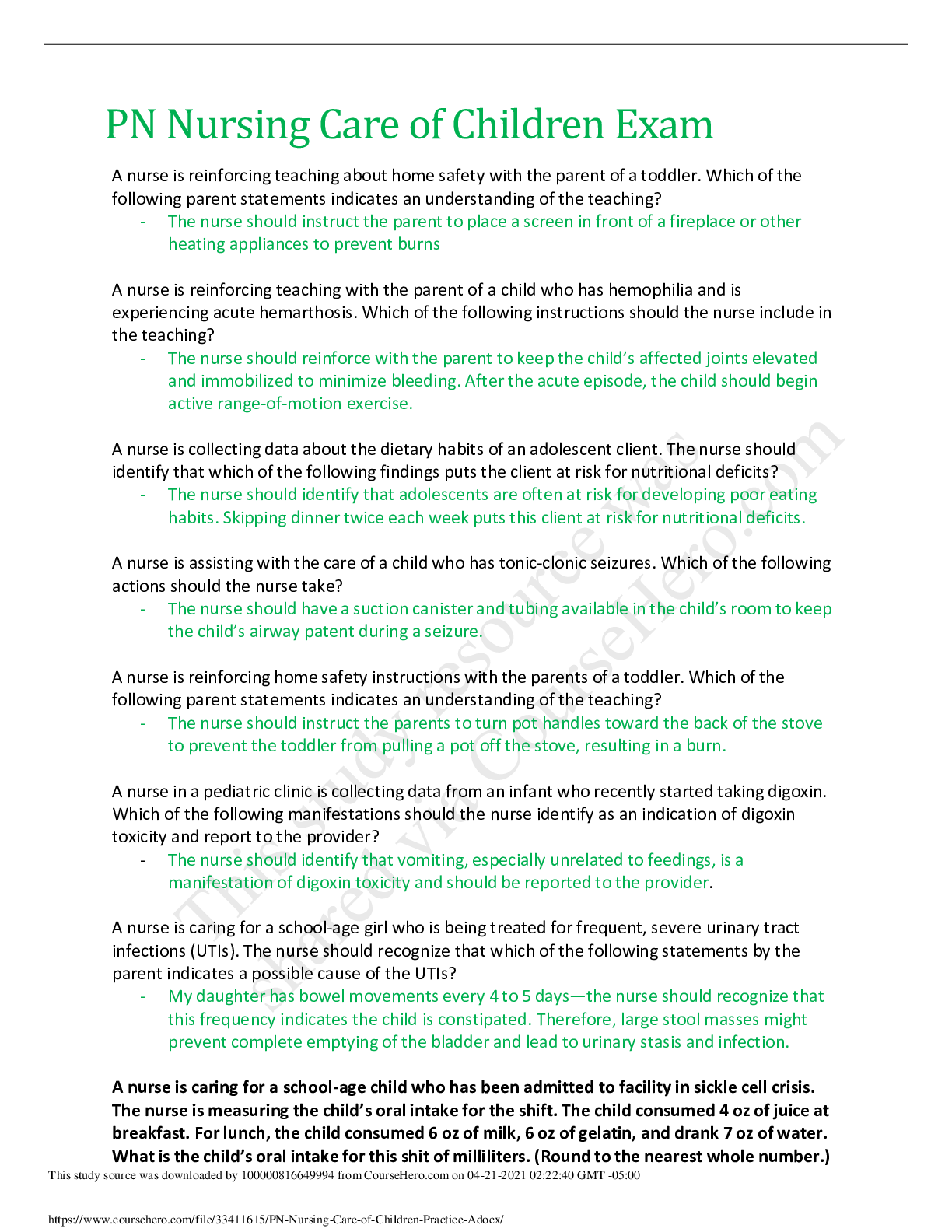


.png)
.png)
